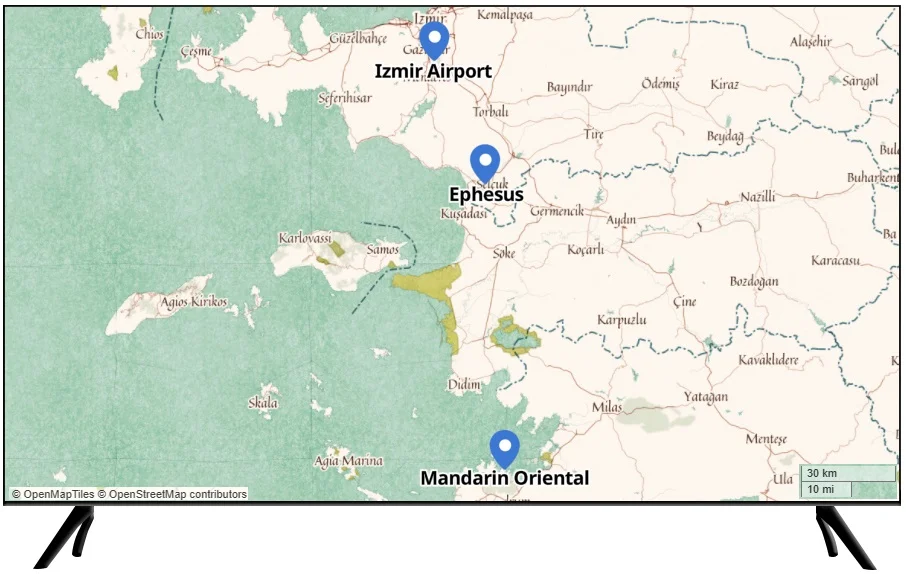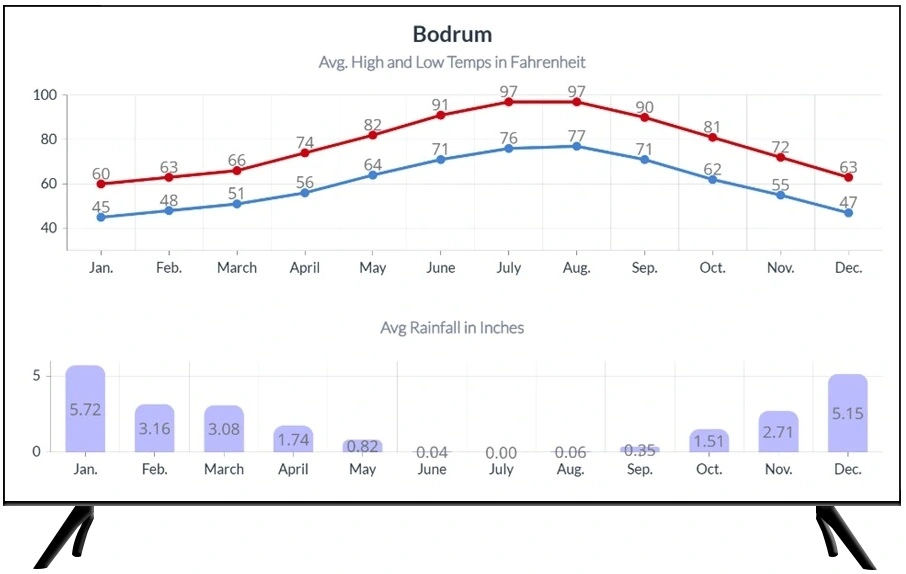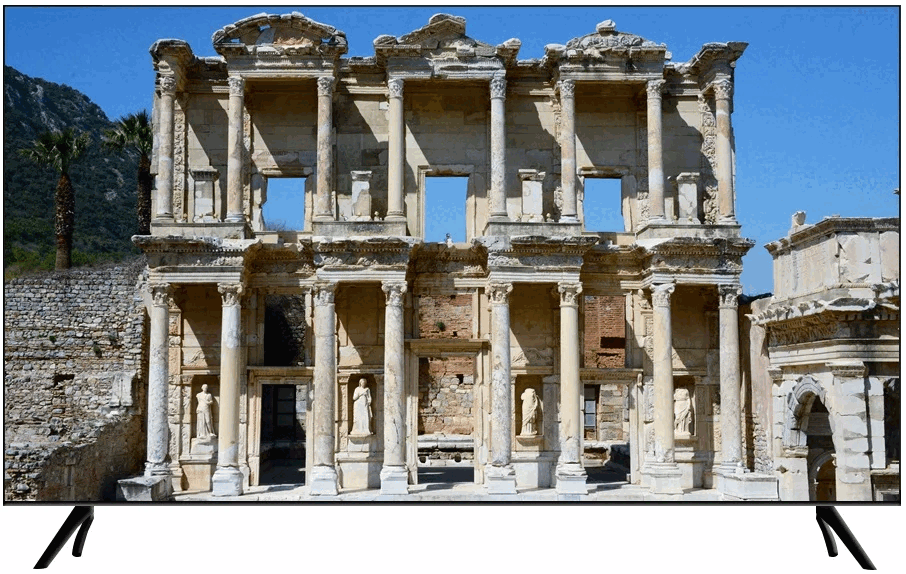


Day 10. Mardin – Izmir (Ephesus) - Bodrum (nonstop flight on Sundays and Tuesdays).
Overnight – Mandarin Oriental
You are assisted with your checkout in the early morning (with a packed breakfast) and driven to Mardin Airport and assisted in boarding your 8:10 AM no-frills (only nonstop option available) flight to Izmir Airport. Arrive at the airport and you are driven to Ephesus, which is one of the world’s most famous archaeological sites for very good reasons.
This UNESCO World Heritage Site was initially settled by the Greeks in 10th Century BC and was taken over by the Romans about 900 years later. There are a lot of incredible structures at this site that are partially intact or have been restored to some of their ancient glory, unlike the nearby Temple of Artemis, which was one of the Seven Wonders of the Ancient World, but now lies completely in ruins. The history of human settlements in the Selcuk/Ephesus area goes back almost 9000 years, starting with the prehistoric settlement at Cukurici Hoyuk.
You will start from the less crowded Upper (southeastern) entrance where the monuments lie at a higher elevation than the rest of the current archaeological site, and make your way downhill through the plethora of ancient attractions. One of the first structures you will explore, after walking through the State Agora, is the 1400 seat Odeion, which was where the Council of Aristocrats met, and which also served as a venue for performances.
As you walk through the massive site of Ephesus you will stop to admire the incredible structures and sculptures that are the most impressive – your guide will relay the history of each monument and its story. Soon you will find yourself on Curetes Street and be rewarded with your first view of the most photographed of the attractions at Ephesus, the Library of Celsus. Your path will now head downslope toward the library, again stopping when you please at the incredible structures around you.
Just before you arrive at the library, you will stop to explore one of the most amazing parts of Ephesus, the Terrace Houses, located across the Temple of Hadrian. These massive aristocratic homes have been undergoing a massive restoration project for many years and were inhabited by rich and powerful Romans from the first century BC until the 7th century AD. The two semi-restored houses have interiors that are about 10,000 sq feet each and the incredible beauty of the materials used in their construction rivals any luxury home available today.
Next you will admire the magnificent façade of the Library of Celsus, then walk through the main Agora where merchants from seafaring ships came to trade. You will proceed further towards the exit, stopping for an exploration of the spectacular Ephesus Theatre. This is actually the most impressive remaining structure at Ephesus and you will enter it and admire the 24,000-seat venue.
Less than two miles of driving will bring you to the town of Selcuk, where we recommend a break for a slightly late lunch. Depending on how long a day, and your interests, we recommend the following other stops in the region before heading to your gorgeous resort in Bodrum.
1. The most interesting place to visit is about 45 minutes from Ephesus, the small ancient town of Tire. Tire is a great destination due to it being a center of exquisite craftsmanship for many centuries, and the Ottoman architecture and culture that still thrives here today. Originally settled by the Hittites, what you will see today in this hillside town originates from the 13th Century fiefdom that made this an important city, and mainly from the rise of the Ottomans in the 14th and 15th Centuries. During the exploration of Tire, we strongly recommend the famous local delicacy, Tire Kofte.
Popular among visitors is the opportunity to buy wonderfully soft felt slippers and shawls, a specialty of the local craftsmen for many centuries. Among today’s experiences will include visits to the traditional felt and saddle makers to watch them at work. Another stop will be at a Beledi weaving center, where cotton is woven on ancient design looms that have up to 24 frames and are controlled by 13 to 16 pedals – this process that the extremely skilled operators use is fascinating to watch.
Another stop can be at a tinsmith where you will see the expert craftsman working on copper products, and another possible stop might be at the only place where they still use the above-mentioned loom to produce some high-quality silk fabrics. https://www.visitizmir.org/en/Content/106 is a good webpage from the Izmir tourism department where you can see some details of this craftsmanship. Tire is also famous for the excellent and extremely colorful clogs made of poplar and willow wood using a complicated multiple step process, which includes making them impervious to getting wet.
2. The impressive Basilica of St. John is in Selcuk and is well worth a visit – access is very easy and the visit does not take much time. It was built by Emperor Justinian I in the 6th Century at the location where St. John is purported to be buried, and modeled after the no longer existing Church of the Holy Apostles in Constantinople. There are massive sections of a Roman Aqueduct and other structures all over Selcuk and an interesting sight you will probably see near the entrance of the basilica is a stork and its hatchlings in their nest on top of one of the Roman pillars.
3. The small but impressive Ephesus Museum is also located within Selcuk and has an excellent collection of artifacts from Ephesus, the Temple of Artemis, and other regional sites, almost all of them in great condition.
4. A 25-minute or so scenic drive from Selcuk into the mountains will bring you to the House of the Virgin Mary, where she is believed to have spent her last years after St. John helped her get here. The site has been visited by several Popes and has received a number of papal Apostolic Blessings. This is an active pilgrimage site and the lines to walk through the small stone house can be very long during the tourism season, but one can easily take in the structure from the exterior without any delay.
At the end of your selected activities, you are driven about 3.5 hours to the Turquoise Coast of Turkey. Bodrum’s history goes back over 3000 years, and it became a major regional city of the Greek Empire about 2500 years ago. You will be assisted with your check-in to your exquisite lodging at the Mandarin Oriental Bodrum.
This UNESCO World Heritage Site was initially settled by the Greeks in 10th Century BC and was taken over by the Romans about 900 years later. There are a lot of incredible structures at this site that are partially intact or have been restored to some of their ancient glory, unlike the nearby Temple of Artemis, which was one of the Seven Wonders of the Ancient World, but now lies completely in ruins. The history of human settlements in the Selcuk/Ephesus area goes back almost 9000 years, starting with the prehistoric settlement at Cukurici Hoyuk.
You will start from the less crowded Upper (southeastern) entrance where the monuments lie at a higher elevation than the rest of the current archaeological site, and make your way downhill through the plethora of ancient attractions. One of the first structures you will explore, after walking through the State Agora, is the 1400 seat Odeion, which was where the Council of Aristocrats met, and which also served as a venue for performances.
As you walk through the massive site of Ephesus you will stop to admire the incredible structures and sculptures that are the most impressive – your guide will relay the history of each monument and its story. Soon you will find yourself on Curetes Street and be rewarded with your first view of the most photographed of the attractions at Ephesus, the Library of Celsus. Your path will now head downslope toward the library, again stopping when you please at the incredible structures around you.
Just before you arrive at the library, you will stop to explore one of the most amazing parts of Ephesus, the Terrace Houses, located across the Temple of Hadrian. These massive aristocratic homes have been undergoing a massive restoration project for many years and were inhabited by rich and powerful Romans from the first century BC until the 7th century AD. The two semi-restored houses have interiors that are about 10,000 sq feet each and the incredible beauty of the materials used in their construction rivals any luxury home available today.
Next you will admire the magnificent façade of the Library of Celsus, then walk through the main Agora where merchants from seafaring ships came to trade. You will proceed further towards the exit, stopping for an exploration of the spectacular Ephesus Theatre. This is actually the most impressive remaining structure at Ephesus and you will enter it and admire the 24,000-seat venue.
Less than two miles of driving will bring you to the town of Selcuk, where we recommend a break for a slightly late lunch. Depending on how long a day, and your interests, we recommend the following other stops in the region before heading to your gorgeous resort in Bodrum.
1. The most interesting place to visit is about 45 minutes from Ephesus, the small ancient town of Tire. Tire is a great destination due to it being a center of exquisite craftsmanship for many centuries, and the Ottoman architecture and culture that still thrives here today. Originally settled by the Hittites, what you will see today in this hillside town originates from the 13th Century fiefdom that made this an important city, and mainly from the rise of the Ottomans in the 14th and 15th Centuries. During the exploration of Tire, we strongly recommend the famous local delicacy, Tire Kofte.
Popular among visitors is the opportunity to buy wonderfully soft felt slippers and shawls, a specialty of the local craftsmen for many centuries. Among today’s experiences will include visits to the traditional felt and saddle makers to watch them at work. Another stop will be at a Beledi weaving center, where cotton is woven on ancient design looms that have up to 24 frames and are controlled by 13 to 16 pedals – this process that the extremely skilled operators use is fascinating to watch.
Another stop can be at a tinsmith where you will see the expert craftsman working on copper products, and another possible stop might be at the only place where they still use the above-mentioned loom to produce some high-quality silk fabrics. https://www.visitizmir.org/en/Content/106 is a good webpage from the Izmir tourism department where you can see some details of this craftsmanship. Tire is also famous for the excellent and extremely colorful clogs made of poplar and willow wood using a complicated multiple step process, which includes making them impervious to getting wet.
2. The impressive Basilica of St. John is in Selcuk and is well worth a visit – access is very easy and the visit does not take much time. It was built by Emperor Justinian I in the 6th Century at the location where St. John is purported to be buried, and modeled after the no longer existing Church of the Holy Apostles in Constantinople. There are massive sections of a Roman Aqueduct and other structures all over Selcuk and an interesting sight you will probably see near the entrance of the basilica is a stork and its hatchlings in their nest on top of one of the Roman pillars.
3. The small but impressive Ephesus Museum is also located within Selcuk and has an excellent collection of artifacts from Ephesus, the Temple of Artemis, and other regional sites, almost all of them in great condition.
4. A 25-minute or so scenic drive from Selcuk into the mountains will bring you to the House of the Virgin Mary, where she is believed to have spent her last years after St. John helped her get here. The site has been visited by several Popes and has received a number of papal Apostolic Blessings. This is an active pilgrimage site and the lines to walk through the small stone house can be very long during the tourism season, but one can easily take in the structure from the exterior without any delay.
At the end of your selected activities, you are driven about 3.5 hours to the Turquoise Coast of Turkey. Bodrum’s history goes back over 3000 years, and it became a major regional city of the Greek Empire about 2500 years ago. You will be assisted with your check-in to your exquisite lodging at the Mandarin Oriental Bodrum.
You are assisted with your checkout in the early morning (with a packed breakfast) and driven to Mardin Airport and assisted in boarding your 8:10 AM no-frills (only nonstop option available) flight to Izmir Airport. Arrive at the airport and you are driven to Ephesus, which is one of the world’s most famous archaeological sites for very good reasons.
This UNESCO World Heritage Site was initially settled by the Greeks in 10th Century BC and was taken over by the Romans about 900 years later. There are a lot of incredible structures at this site that are partially intact or have been restored to some of their ancient glory, unlike the nearby Temple of Artemis, which was one of the Seven Wonders of the Ancient World, but now lies completely in ruins. The history of human settlements in the Selcuk/Ephesus area goes back almost 9000 years, starting with the prehistoric settlement at Cukurici Hoyuk.
You will start from the less crowded Upper (southeastern) entrance where the monuments lie at a higher elevation than the rest of the current archaeological site, and make your way downhill through the plethora of ancient attractions. One of the first structures you will explore, after walking through the State Agora, is the 1400 seat Odeion, which was where the Council of Aristocrats met, and which also served as a venue for performances.
As you walk through the massive site of Ephesus you will stop to admire the incredible structures and sculptures that are the most impressive – your guide will relay the history of each monument and its story. Soon you will find yourself on Curetes Street and be rewarded with your first view of the most photographed of the attractions at Ephesus, the Library of Celsus. Your path will now head downslope toward the library, again stopping when you please at the incredible structures around you.
Just before you arrive at the library, you will stop to explore one of the most amazing parts of Ephesus, the Terrace Houses, located across the Temple of Hadrian. These massive aristocratic homes have been undergoing a massive restoration project for many years and were inhabited by rich and powerful Romans from the first century BC until the 7th century AD. The two semi-restored houses have interiors that are about 10,000 sq feet each and the incredible beauty of the materials used in their construction rivals any luxury home available today.
Next you will admire the magnificent façade of the Library of Celsus, then walk through the main Agora where merchants from seafaring ships came to trade. You will proceed further towards the exit, stopping for an exploration of the spectacular Ephesus Theatre. This is actually the most impressive remaining structure at Ephesus and you will enter it and admire the 24,000-seat venue.
Less than two miles of driving will bring you to the town of Selcuk, where we recommend a break for a slightly late lunch. Depending on how long a day, and your interests, we recommend the following other stops in the region before heading to your gorgeous resort in Bodrum.
1. The most interesting place to visit is about 45 minutes from Ephesus, the small ancient town of Tire. Tire is a great destination due to it being a center of exquisite craftsmanship for many centuries, and the Ottoman architecture and culture that still thrives here today. Originally settled by the Hittites, what you will see today in this hillside town originates from the 13th Century fiefdom that made this an important city, and mainly from the rise of the Ottomans in the 14th and 15th Centuries. During the exploration of Tire, we strongly recommend the famous local delicacy, Tire Kofte.
Popular among visitors is the opportunity to buy wonderfully soft felt slippers and shawls, a specialty of the local craftsmen for many centuries. Among today’s experiences will include visits to the traditional felt and saddle makers to watch them at work. Another stop will be at a Beledi weaving center, where cotton is woven on ancient design looms that have up to 24 frames and are controlled by 13 to 16 pedals – this process that the extremely skilled operators use is fascinating to watch.
Another stop can be at a tinsmith where you will see the expert craftsman working on copper products, and another possible stop might be at the only place where they still use the above-mentioned loom to produce some high-quality silk fabrics. https://www.visitizmir.org/en/Content/106 is a good webpage from the Izmir tourism department where you can see some details of this craftsmanship. Tire is also famous for the excellent and extremely colorful clogs made of poplar and willow wood using a complicated multiple step process, which includes making them impervious to getting wet.
2. The impressive Basilica of St. John is in Selcuk and is well worth a visit – access is very easy and the visit does not take much time. It was built by Emperor Justinian I in the 6th Century at the location where St. John is purported to be buried, and modeled after the no longer existing Church of the Holy Apostles in Constantinople. There are massive sections of a Roman Aqueduct and other structures all over Selcuk and an interesting sight you will probably see near the entrance of the basilica is a stork and its hatchlings in their nest on top of one of the Roman pillars.
3. The small but impressive Ephesus Museum is also located within Selcuk and has an excellent collection of artifacts from Ephesus, the Temple of Artemis, and other regional sites, almost all of them in great condition.
4. A 25-minute or so scenic drive from Selcuk into the mountains will bring you to the House of the Virgin Mary, where she is believed to have spent her last years after St. John helped her get here. The site has been visited by several Popes and has received a number of papal Apostolic Blessings. This is an active pilgrimage site and the lines to walk through the small stone house can be very long during the tourism season, but one can easily take in the structure from the exterior without any delay.
At the end of your selected activities, you are driven about 3.5 hours to the Turquoise Coast of Turkey. Bodrum’s history goes back over 3000 years, and it became a major regional city of the Greek Empire about 2500 years ago. You will be assisted with your check-in to your exquisite lodging at the Mandarin Oriental Bodrum.
This UNESCO World Heritage Site was initially settled by the Greeks in 10th Century BC and was taken over by the Romans about 900 years later. There are a lot of incredible structures at this site that are partially intact or have been restored to some of their ancient glory, unlike the nearby Temple of Artemis, which was one of the Seven Wonders of the Ancient World, but now lies completely in ruins. The history of human settlements in the Selcuk/Ephesus area goes back almost 9000 years, starting with the prehistoric settlement at Cukurici Hoyuk.
You will start from the less crowded Upper (southeastern) entrance where the monuments lie at a higher elevation than the rest of the current archaeological site, and make your way downhill through the plethora of ancient attractions. One of the first structures you will explore, after walking through the State Agora, is the 1400 seat Odeion, which was where the Council of Aristocrats met, and which also served as a venue for performances.
As you walk through the massive site of Ephesus you will stop to admire the incredible structures and sculptures that are the most impressive – your guide will relay the history of each monument and its story. Soon you will find yourself on Curetes Street and be rewarded with your first view of the most photographed of the attractions at Ephesus, the Library of Celsus. Your path will now head downslope toward the library, again stopping when you please at the incredible structures around you.
Just before you arrive at the library, you will stop to explore one of the most amazing parts of Ephesus, the Terrace Houses, located across the Temple of Hadrian. These massive aristocratic homes have been undergoing a massive restoration project for many years and were inhabited by rich and powerful Romans from the first century BC until the 7th century AD. The two semi-restored houses have interiors that are about 10,000 sq feet each and the incredible beauty of the materials used in their construction rivals any luxury home available today.
Next you will admire the magnificent façade of the Library of Celsus, then walk through the main Agora where merchants from seafaring ships came to trade. You will proceed further towards the exit, stopping for an exploration of the spectacular Ephesus Theatre. This is actually the most impressive remaining structure at Ephesus and you will enter it and admire the 24,000-seat venue.
Less than two miles of driving will bring you to the town of Selcuk, where we recommend a break for a slightly late lunch. Depending on how long a day, and your interests, we recommend the following other stops in the region before heading to your gorgeous resort in Bodrum.
1. The most interesting place to visit is about 45 minutes from Ephesus, the small ancient town of Tire. Tire is a great destination due to it being a center of exquisite craftsmanship for many centuries, and the Ottoman architecture and culture that still thrives here today. Originally settled by the Hittites, what you will see today in this hillside town originates from the 13th Century fiefdom that made this an important city, and mainly from the rise of the Ottomans in the 14th and 15th Centuries. During the exploration of Tire, we strongly recommend the famous local delicacy, Tire Kofte.
Popular among visitors is the opportunity to buy wonderfully soft felt slippers and shawls, a specialty of the local craftsmen for many centuries. Among today’s experiences will include visits to the traditional felt and saddle makers to watch them at work. Another stop will be at a Beledi weaving center, where cotton is woven on ancient design looms that have up to 24 frames and are controlled by 13 to 16 pedals – this process that the extremely skilled operators use is fascinating to watch.
Another stop can be at a tinsmith where you will see the expert craftsman working on copper products, and another possible stop might be at the only place where they still use the above-mentioned loom to produce some high-quality silk fabrics. https://www.visitizmir.org/en/Content/106 is a good webpage from the Izmir tourism department where you can see some details of this craftsmanship. Tire is also famous for the excellent and extremely colorful clogs made of poplar and willow wood using a complicated multiple step process, which includes making them impervious to getting wet.
2. The impressive Basilica of St. John is in Selcuk and is well worth a visit – access is very easy and the visit does not take much time. It was built by Emperor Justinian I in the 6th Century at the location where St. John is purported to be buried, and modeled after the no longer existing Church of the Holy Apostles in Constantinople. There are massive sections of a Roman Aqueduct and other structures all over Selcuk and an interesting sight you will probably see near the entrance of the basilica is a stork and its hatchlings in their nest on top of one of the Roman pillars.
3. The small but impressive Ephesus Museum is also located within Selcuk and has an excellent collection of artifacts from Ephesus, the Temple of Artemis, and other regional sites, almost all of them in great condition.
4. A 25-minute or so scenic drive from Selcuk into the mountains will bring you to the House of the Virgin Mary, where she is believed to have spent her last years after St. John helped her get here. The site has been visited by several Popes and has received a number of papal Apostolic Blessings. This is an active pilgrimage site and the lines to walk through the small stone house can be very long during the tourism season, but one can easily take in the structure from the exterior without any delay.
At the end of your selected activities, you are driven about 3.5 hours to the Turquoise Coast of Turkey. Bodrum’s history goes back over 3000 years, and it became a major regional city of the Greek Empire about 2500 years ago. You will be assisted with your check-in to your exquisite lodging at the Mandarin Oriental Bodrum.

